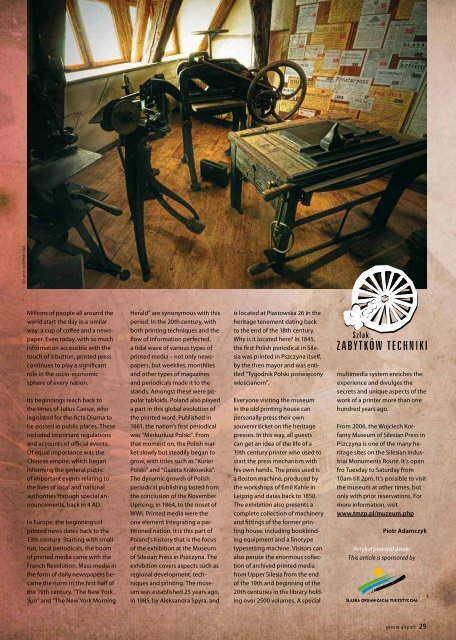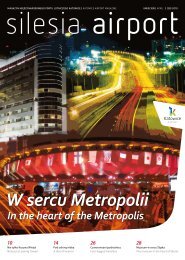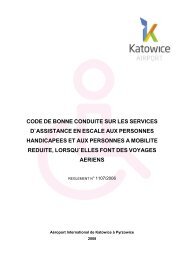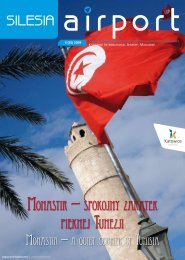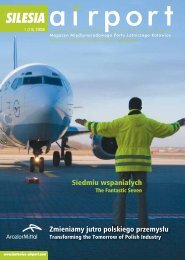Create successful ePaper yourself
Turn your PDF publications into a flip-book with our unique Google optimized e-Paper software.
fot. arch: Śot/Piotr oleś<br />
Millions of people all around the<br />
world start the day in a similar<br />
way: a cup of coffee and a newspaper.<br />
Even today, with so much<br />
information accessible with the<br />
touch of a button, printed press<br />
continues to play a significant<br />
role in the socio-economic<br />
sphere of every nation.<br />
Its beginnings reach back to<br />
the times of Julius Caesar, who<br />
legislated for the Acta Diurna to<br />
be posted in public places. These<br />
included important regulations<br />
and accounts of official events.<br />
Of equal importance was the<br />
Chinese empire, which began<br />
informing the general public<br />
of important events relating to<br />
the lives of local and national<br />
authorities through special announcements,<br />
back in 4 AD.<br />
In Europe, the beginnings of<br />
printed news dates back to the<br />
13th century. Starting with smallrun,<br />
local periodicals, the boom<br />
of printed media came with the<br />
French Revolution. Mass media in<br />
the form of daily newspapers became<br />
the norm in the first half of<br />
the 19th century. “The New York<br />
Sun” and “The New York Morning<br />
Herald” are synonymous with this<br />
period. In the 20th century, with<br />
both printing techniques and the<br />
flow of information perfected,<br />
a tidal wave of various types of<br />
printed media – not only newspapers,<br />
but weeklies, monthlies<br />
and other types of magazines<br />
and periodicals made it to the<br />
stands. Amongst these were popular<br />
tabloids. Poland also played<br />
a part in this global evolution of<br />
the printed word. Published in<br />
1661, the nation’s first periodical<br />
was “Merkuriusz Polski”. From<br />
that moment on, the Polish market<br />
slowly but steadily began to<br />
grow, with titles such as “Kurier<br />
Polski” and “Gazeta Krakowska”.<br />
The dynamic growth of Polish<br />
periodical publishing lasted from<br />
the conclusion of the November<br />
Uprising, in 1864, to the onset of<br />
WWI. Printed media were the<br />
one element integrating a partitioned<br />
nation. It is this part of<br />
Poland’s history that is the focus<br />
of the exhibition at the Museum<br />
of Silesian Press in Pszczyna. The<br />
exhibition covers aspects such as<br />
regional development, techniques<br />
and printing. The museum<br />
was established 25 years ago,<br />
in 1985, by Aleksandra Spyra, and<br />
is located at Piastowska 26 in the<br />
heritage tenement dating back<br />
to the end of the 18th century.<br />
Why is it located here? In 1845,<br />
the first Polish periodical in Silesia<br />
was printed in Pszczyna itself,<br />
by the then mayor and was entitled<br />
“Tygodnik Polski poświęcony<br />
włościanom”.<br />
Everyone visiting the museum<br />
in the old printing house can<br />
personally press their own<br />
souvenir ticket on the heritage<br />
presses. In this way, all guests<br />
can get an idea of the life of a<br />
19th century printer who used to<br />
start the press mechanism with<br />
his own hands. The press used is<br />
a Boston machine, produced by<br />
the workshops of Emil Kahle in<br />
Leipzig and dates back to 1850.<br />
The exhibition also presents a<br />
complete collection of machinery<br />
and fittings of the former printing<br />
house, including bookbinding<br />
equipment and a linotype<br />
typesetting machine. Visitors can<br />
also peruse the enormous collection<br />
of archived printed media<br />
from Upper Silesia from the end<br />
of the 19th and beginning of the<br />
20th centuries in the library holding<br />
over 2500 volumes. A special<br />
multimedia system enriches the<br />
experience and divulges the<br />
secrets and unique aspects of the<br />
work of a printer more than one<br />
hundred years ago.<br />
From 2006, the Wojciech Korfanty<br />
Museum of Silesian Press in<br />
Pszczyna is one of the many heritage<br />
sites on the Silesian Industrial<br />
Monuments Route. It’s open<br />
fro Tuesday to Saturday from<br />
10am till 2pm. It’s possible to visit<br />
the museum at other times, but<br />
only with prior reservations. For<br />
more information, visit<br />
www.tmzp.pl/muzeum.php<br />
Piotr adamczyk<br />
Artykuł powstał dzięki<br />
this article is sponsored by<br />
silesia airport 29


